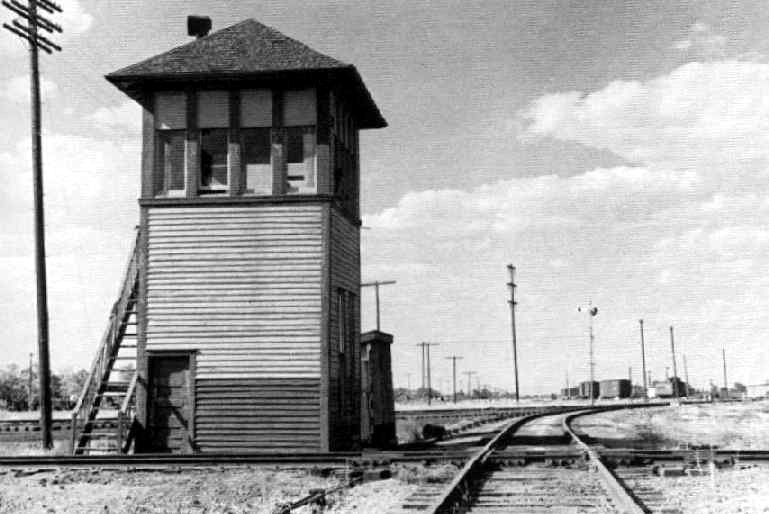
Above: Tower 27, as pictured in The Quanah Route, by Don L. Hofsommer (1991, Texas A&M University Press)
The Story of the Quanah, Acme &
Pacific Railway

Above: Tower 27, as pictured in
The Quanah Route, by Don L. Hofsommer
(1991, Texas A&M University Press)
When the Ft. Worth & Denver City (FW&DC) Railway built
north out of Ft. Worth in the early 1880s, its
objective was to complete a line to the New Mexico border in the upper Texas
Panhandle, part of a lengthy route between its namesake towns. ("City" was
officially dropped from the FW&DC's name on August 7, 1951, hence both "FW&DC" and
"FW&D" are used as acronyms.) Tracks reached Wichita Falls in 1882 and the route
continued west, paralleling the Red River several miles to the south. Survey
teams had identified future water stops and towns, one of which was named Quanah
for the famous Comanche Chief, Quanah Parker. Lots were being sold in Quanah by
1885 and a Post Office opened in 1886, even though the railroad didn't arrive
until the following year. By 1890, the town's prosperity was sufficient to win
an election to become the seat of Hardeman County. Deposits of natural cement
and gypsum were discovered near Quanah, leading to the development of a local
industry with two plants manufacturing cement and gypsum products. In 1898, a post office opened at the
community of Acme
where the cement and plaster industry was centered, 6 miles west of Quanah along the FW&DC
main line.
One of the two plants, the Acme Cement Plaster Co. owned by
Samuel Lazarus, was directly adjacent to the rail line at Acme and arranged for
the FW&DC to perform switching duties. The other plant, the Salina Cement
Plaster Co., was north of Acme. It also needed rail service but could not reach
the FW&DC tracks without crossing Lazarus' property. Lazarus refused to grant an
easement, so a new railroad, the Acme Tap, was chartered in 1899 by the Salina
plant's owners. The state charter enabled the Acme Tap to condemn an easement across
Lazarus' property so it could build the mile and a half of track needed to reach
the main line. The FW&DC performed the rail construction for the Acme Tap
and also supplied the equipment needed to operate it and switch the Salina plant.
Additional private tracks were built north of the Salina plant to reach gypsum
deposits.

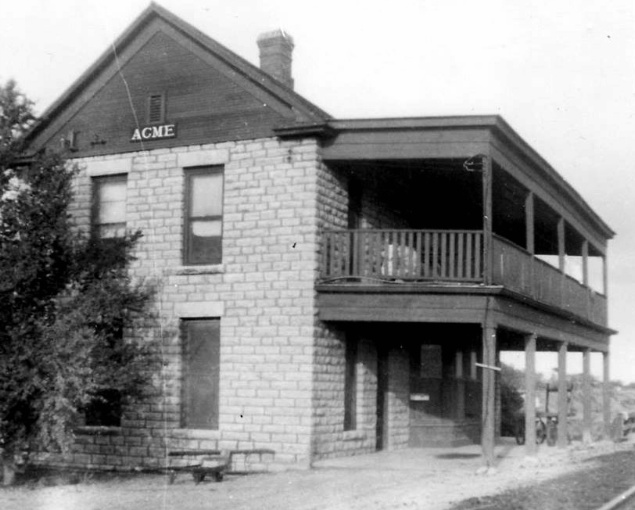
Above Left: FW&D #201 at Acme,
photo undated (Billy Brackenridge collection)
Above Right: undated photo of the
FW&D railroad station at Acme (Kerry Kennington family collection)
Business was good, but Samuel Lazarus was unhappy with the freight
rates being offered by the FW&DC. His solution was to build his own railroad to reach
another connection that could provide suitable competition. For this purpose, his Acme, Red River
& Northern (ARR&N) Railroad was chartered in 1902 with a vague plan to build to
the Red River, bridge it, and continue to Mangum, Oklahoma to connect with the Rock Island
railroad.
But bridging the river was beyond Lazarus' budget, so he looked for another
opportunity. At the time, the St. Louis - San Francisco (SL-SF, "Frisco")
Railway had begun building southwest out of Oklahoma City toward the Red River
with plans to enter Texas. Lazarus proposed to the Frisco that they alter their
planned route and meet his new railroad at the Red River north of Quanah. An
agreement was reached, but it was soon modified to have the ARR&N build directly to
Quanah instead.
Texas law mandated that all railroads
owning tracks in Texas be headquartered in Texas. In the initial plan,
the ARR&N would have fulfilled that requirement for the Frisco by meeting them at the Red
River. Under the revised plan, the Frisco needed to charter a railroad, the Oklahoma City & Texas (OC&T) Railroad, to
own the nine miles from the river to Quanah. This was not unusual for the Frisco;
they had chartered Texas subsidiaries in the past merely to comply with the law,
e.g. the
St. Louis, San Francisco & Texas Railway (SLSF&T) at
Denison,
the
Paris & Great Northern Railroad at Paris, and
the Red River, Texas & Southern Railroad from Sherman
to Carrollton. The
OC&T line to Quanah was completed in 1903, and the following year, the
Frisco merged most of its Texas subsidiaries, including the OC&T, into the
SLSF&T. Although the SLSF&T continued operating as a wholly-owned subsidiary
until 1962, most (or perhaps all) of its rolling stock belonged to its parent
company. It was, in essence, a holding company for Frisco's operations in Texas.
| The OC&T's tracks into Quanah made a connection on the north side of town with
the FW&DC. They also crossed over it and continued down the center of McClelland
St. to 10th St., nearly three quarters of a mile farther south. This enabled the Frisco to
serve businesses in town and also provided a location for a passenger station
between 3rd and
4th streets. On October 5, 1903, the Railroad
Commission of Texas (RCT) gave approval for commencement of operations of the manned interlocking
tower that had been built at the crossing of the OC&T and
the FW&DC. Designated Tower 27, the interlocker was a 19-function mechanical plant
built by the Pneumatic Signal Co. of Rochester, New York. Since the OC&T was the
"second railroad", i.e. the one that created the crossing, they were responsible
for the capital outlay to build the interlocking tower. (Had the crossing
existed when Texas' new interlocker law took effect in 1901, the capital expense
would have been shared by both railroads.) By the end of 1904, RCT documentation had
been updated to show the SLSF&T replacing the OC&T as a participating railroad at Tower 27. RCT statistics show that during
the 12 months ending June 30, 1906, an average of 17 train movements per day
passed Tower 27. Right: Austin Daily Statesman, November 8, 1902 Even if the Frisco was responsible for paying to design and erect Tower 27, it's still possible that the FW&DC actually performed the engineering work and built the structure. That is, whether this was a "Frisco tower" or an "FW&DC tower" has not been conclusively established with respect to its design and construction. From an operational standpoint, it was a Frisco tower. |
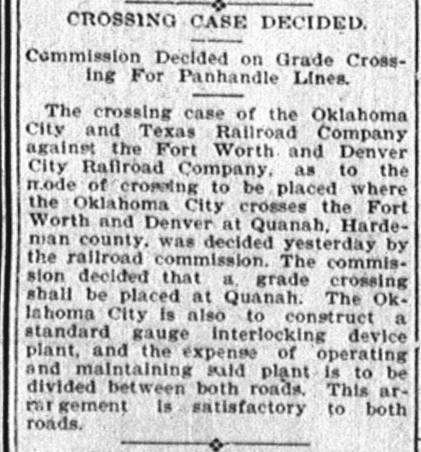
|
RCT's Annual Report of
1917 was the first to list the railroads at each tower in a particular order
such that "First Railroad named Operates the Interlocker". It listed the SLSF&T
first, indicating it was the railroad responsible for operating Tower 27 (it
also showed the function count had increased to 34; most likely, exchange track signaling
and switching was becoming more extensive.) In almost every case where the
details are known, the railroad with the responsibility for operating the
interlocker was also the railroad that designed and built the tower, regardless
of which railroad (or perhaps both) had funded it. The reason
for this was simple: railroads liked to be able to relocate and "fill in"
personnel among multiple towers as needs and vacancies arose, and as traffic and
operational hours changed (many towers were not staffed 24/7, and hours were
often discontinuous on Sundays.) With each railroad mostly staffing only the
towers it had built, its operations benefitted from having commonality in its
tower designs. While the capital costs for Tower 27 would have been borne by the
Frisco, annual recurring costs for operations and maintenance would have been
shared, typically on a "weighted function" basis subject to negotiation between
the railroads involved, here, the Frisco and the FW&DC.
The OC&T was supposed to connect with the ARR&N at
Quanah, but the ARR&N was nowhere to be found! Before
Lazarus could build the ARR&N line into Quanah, the FW&DC made a proposal. They
would grant rights to the ARR&N to handle the switching duties at both plaster
companies, and also grant rights for the ARR&N to use the FW&DC main line
into
Quanah.
For its part, the ARR&N would agree not to build its own line into Quanah.
Lazarus accepted the FW&DC's offer; the ARR&N began switching both plaster plants which included
a 10-year lease on the Acme Tap. The ARR&N regularly used the FW&DC main line to move freight cars to and from
Tower 27 to exchange with the Frisco. Exchanges with the FW&DC could be done at
Acme.
In 1909, the ARR&N was re-chartered
as the Quanah, Acme & Pacific (QA&P) Railway which immediately announced plans to expand
west from Acme with the intention of planting new ranching towns in the sparsely
populated region. The QA&P's ultimate (though unlikely) goal to reach El Paso
was included in the new charter. The QA&P purchased a right-of-way
200 ft. wide on the south side of the FW&DC from Acme to Quanah to reach new passenger and
freight stations they planned to build a block south of the FW&DC near
downtown. Once again, to deter the QA&P,
the FW&DC proposed to amend the existing switching and trackage rights
agreement. They would build a spur off their main line to serve the QA&P's
planned passenger and freight stations. In exchange, the QA&P would agree not to
build their own line into Quanah. The offer was accepted, and the stations and
the spur were built. At some point, the Frisco abandoned its
passenger station and began sharing the new QA&P station, but the date when
that occurred has not been established.
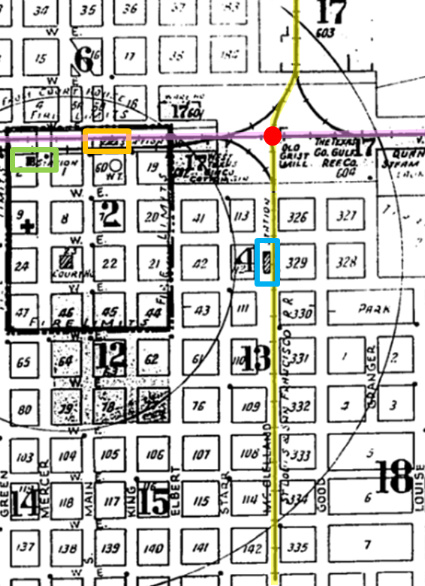 |
Left:
This 1931 index map from the Sanborn Fire Insurance Co. has been
annotated to show the Frisco tracks (yellow highlight) coming into
Quanah from the north, continuing south down McClelland St., and ending
at Tenth St. The Frisco's passenger station (blue rectangle) sat along
McClelland between Third St. and Fourth St. (although by this date, it
was likely abandoned in favor of using the QA&P depot.) The FW&DC tracks (pink highlight) run east/west through Quanah, with Tower 27 located at the FW&DC / Frisco crossing (red circle). Assuming the photo of Tower 27 above looks due north with the QA&P/Frisco yard in the background (and with the track slightly curving to the east as depicted on the map), it appears that Tower 27 was located in the northwest quadrant of the diamond. The QA&P depot (green rectangle) and FW&DC depot (orange rectangle) were west of Tower 27, due north of the courthouse square. Because this map dates from 1931, after the QA&P lost trackage rights on the FW&DC, the (un-highlighted) track on the north side of the QA&P depot extends east and connects to the Frisco tracks going north at Tower 27. This connection was added because the spur track off the FW&DC (farther west) that had provided depot access was no longer available due to the termination of the trackage rights agreement. By the 1931 date of this map, the Frisco tracks had been leased to the QA&P for many years (since 1914), a situation that appears to have remained in effect until the demise of the QA&P. |
 |
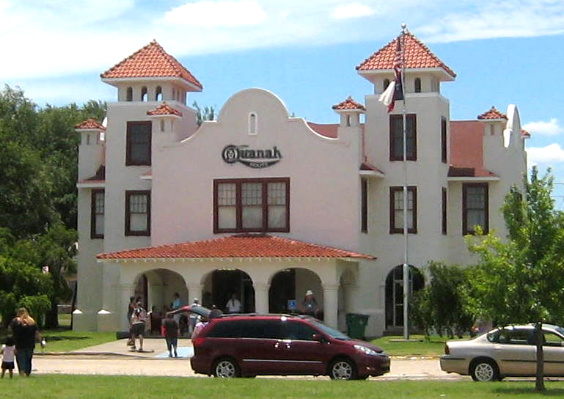
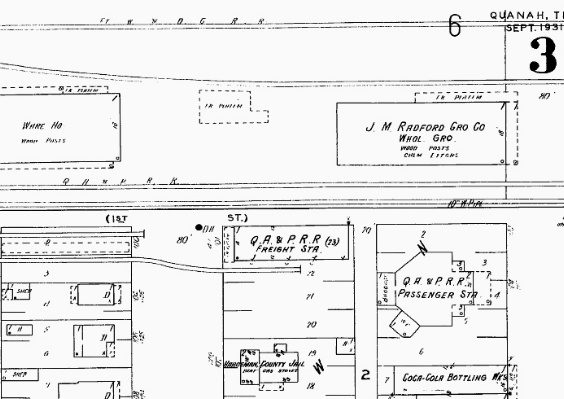
Above Left: This view of the QA&P passenger depot was
taken in June, 2008 during the excursion to Quanah that was part of the Lone
Star Rails 2008 convention of the National Railway Historical Society (NRHS). The depot
houses the Hardeman County Historical Museum. (Jim King photo)
Above Right: The 1931 Sanborn
Fire Insurance map of Quanah shows that the QA&P had a freight station
adjacent to
their passenger depot. The Coca-Cola Bottling Works and the county jail were also
nearby. The jail has survived as a historical structure.
With the arrangements in Quanah settled, the QA&P
focused on their plan to expand west. As they already had FW&DC trackage rights
from Quanah, the QA&P's route west began with a switch off the main
track at Acme. They proceeded southwest to Paducah, an
existing town reached easily in 1910. The terrain farther west presented
much more difficult construction due to the looming Caprock Escarpment. To raise capital for the venture, a series of
complicated financial arrangements appeared to leave the Frisco owning a controlling
interest in the QA&P. An agreement was reached wherein the Frisco guaranteed the
construction bonds of the QA&P but this did not settle the ownership
question. The financial
arrangements were complex due in part to the Frisco's reorganization in
bankruptcy between 1913 and 1916. As late as 1922, the QA&P was still notifying
the Interstate Commerce Commission (ICC) that "...records
of this company reflect no such control nor does SL&SF Railroad Company exercise
control." This statement was in a letter sent each year in response to the
ICC's annual report listing the QA&P's capital stock as entirely owned by the
Frisco. When all the financial dust settled, the QA&P was indeed owned by
the Frisco, but continued to operate independently.
With funding
in place, construction west from Paducah began in 1913 and proceeded toward the
vast ranchland of the Matador Land and Cattle Co. which had granted a
right-of-way. Along the way, a camp eight miles south of the town of Matador
(where the ranch was headquartered)
became the new town of Roaring Springs. Construction
continued another four miles west ending at MacBain, forty
miles from Paducah. MacBain was named for the head of the Matador company,
John MacBain, who anticipated the site becoming a livestock loading point.
The QA&P would not build beyond MacBain for more than a dozen years,
and during this period, operations along the entire line west of Quanah were sustained in part by
shipping cattle. The QA&P tracks were a boon to ranchers who could
conveniently move
cattle to markets in Ft. Worth and Oklahoma City. Transporting cattle by
rail required compliance with laws regarding watering, feeding and rest, and cattle
pens to support such stops also had to be built. Railroads were repeatedly
subject to claims by ranchers whenever cattle died en route. It was a difficult
but worthwhile business, and it helped to maintain cash flow for many years.
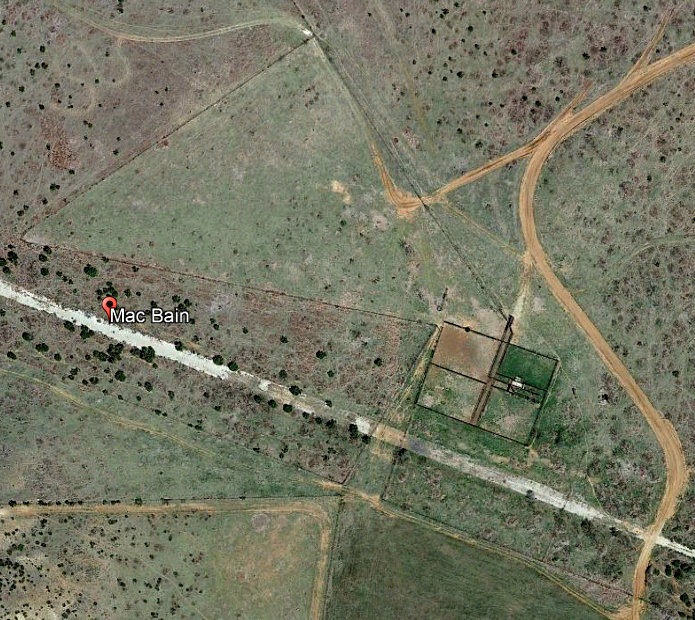 |
Left: Current maps show MacBain at latitude 33 53 37 N, longitude 100 58 29 W, about four miles farther west than it was when the QA&P was being built. The cattle shipping point was relocated in later years, and the stock pens built there remain intact adjacent to the abandoned QA&P grade. (Google Earth, 2016) |
World War I came and went, disrupting railroads with the creation of the U. S.
Railroad Administration. In the post-war era of the early 1920s, Texas railroads
had begun to examine the
landscape for new opportunities, one of which was the area of farm
production on the South Plains of Texas near Plainview and Lubbock, above the Caprock Escarpment. The QA&P and
the FW&DC saw viable business prospects in the area which was already
served to some extent by Santa Fe. Various plans were submitted to the ICC, and
after much delay and vigorous opposition by Santa Fe, some were approved. One of
the projects recommended by the ICC was the QA&P's proposal to build west from MacBain to
Floydada, a town chosen because it was nearby and had an existing rail line to Plainview. Floydada had become a
railroad town in 1910 when its citizens organized a company called the Llano
Estacado Railway to build a branch to Floydada from an existing rail line at Plainview. As grading operations
commenced that year, the Pecos & Northern Texas (P&NT) Railway acquired the assets and
completed the 27 miles to Floydada. The P&NT was a subsidiary of Santa Fe, and
the line to Floydada became one of several Santa Fe branches in the South Plains.
From MacBain, the QA&P had preferred to build to either Lubbock or
Plainview, but competition from the FW&DC and Santa Fe was coming quickly on the South
Plains. The QA&P did
not want to be stuck forever with a dead-end at MacBain while there was a good likelihood of approval to build to
Floydada. It was only 27 miles away on the plains atop the Caprock
Escarpment, but to get onto those plains, eight rugged miles of construction
remained. There were unexpected
financial delays that irked the citizens of Floydada who had promised
right-of-way and land for a depot, expecting the rails to arrive sooner
than they did. The QA&P's construction finally commenced west from
MacBain on June 15, 1927 and the rails reached Floydada in April, 1928.
While the locals were thrilled to have a new rail line providing faster service to Ft. Worth, St. Louis and
points east, Santa
Fe did not want its branch line at Floydada to connect with the QA&P. In particular, they did not want to exchange Frisco traffic over
this branch line because Santa Fe and the Frisco already had a
better connection at Avard, Oklahoma. But after limited negotiations, the rail connection
was made, and soon, a small flow of connecting traffic began to materialize
through Floydada.
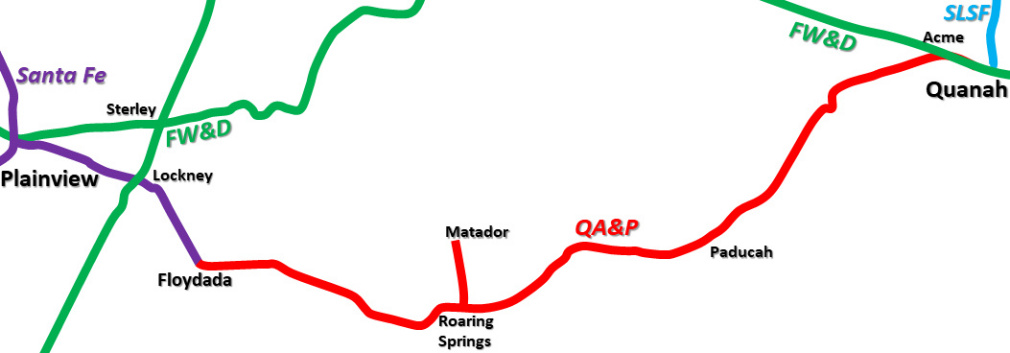 Above:
The Matador Land & Cattle Co. had
offered to share land sales at Roaring Springs with the QA&P, knowing
that a route through
Matador, the seat of Motley County, would have provided no opportunity for townsite
development. Matador residents were miffed, believing that the
presence of the railroad would result in Roaring Springs becoming the county seat,
leaving Matador to wither. To counter this, in 1914 they organized and built the Motley
County Railway, an 8-mile track to a QA&P junction three miles east of
Roaring Springs. Whether or
not their strategy was actually vindicated, Matador remains the county seat
and is still larger than Roaring Springs. The line became a QA&P branch in 1926 and
was abandoned in 1936. Above:
The Matador Land & Cattle Co. had
offered to share land sales at Roaring Springs with the QA&P, knowing
that a route through
Matador, the seat of Motley County, would have provided no opportunity for townsite
development. Matador residents were miffed, believing that the
presence of the railroad would result in Roaring Springs becoming the county seat,
leaving Matador to wither. To counter this, in 1914 they organized and built the Motley
County Railway, an 8-mile track to a QA&P junction three miles east of
Roaring Springs. Whether or
not their strategy was actually vindicated, Matador remains the county seat
and is still larger than Roaring Springs. The line became a QA&P branch in 1926 and
was abandoned in 1936.In the mid-1920s, the FW&DC began an aggressive push to gain ICC approval of proposed routes onto the South Plains. In 1927, the FW&DC started construction on a branch from their main line at Estelline, 44 miles northwest of Quanah, and ventured west into the Caprock. It required two tunnels to get atop the escarpment to reach Plainview in 1928, continuing to Dimmitt that same year. They also built a new line between Silverton and Lubbock that crossed the Santa Fe at Lockney. Where the two new FW&DC lines crossed, the tiny community of Sterley arose. Trains from the FW&DC at Estelline could proceed west to Sterley and turn south, creating a rail route between Ft. Worth and Lubbock. Meanwhile, Santa Fe already had a major secondary line between Lubbock and Canyon via Plainview, with branches to Floydada and Crosbyton, plus additional lines out of Lubbock. They viewed the South Plains as their territory, and they were not happy to see other railroads invading it. Right: This Associated Press article dated September 11, 1925 appeared in the Calexico Chronicle (California) newspaper describing the competition underway among railroads wanting to serve the South Plains of Texas. Of the final two railroads mentioned in the article, only the Gulf, Texas & Western actually existed. By 1910, it had managed to lay 75 miles of track from Jacksboro to Seymour heading generally toward the Caprock, but it never continued onward to the South Plains. After stints as both a Frisco and a Rock Island property, the line was abandoned in 1942. The Texas, Panhandle & Gulf was a company that proposed to build a rail line from Ft. Worth to Tucumcari, New Mexico. When the ICC approved their application in March, 1926, they were given six months to acquire the necessary capital to begin construction. They failed to do so and their application was dismissed by the ICC in September. |
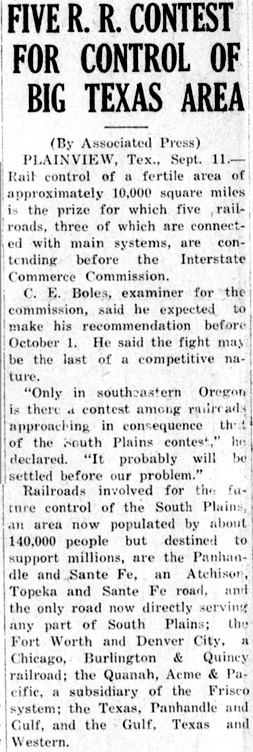 |
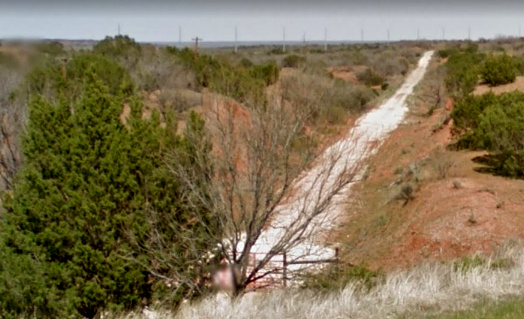
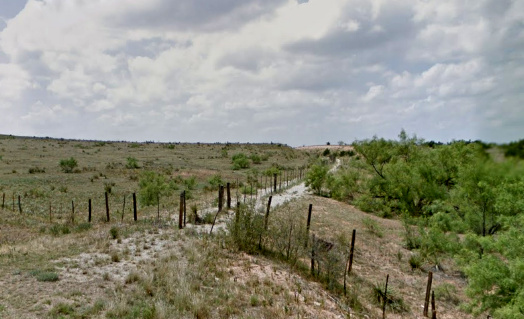
Above Left:
abandoned QA&P right-of-way viewed northeast from US 70 west of Paducah
Above Right: abandoned QA&P
right-of-way nearing the top of the Caprock, viewed northwest from Farm Road 684
Below Left: Paducah
Heritage Museum in the old QA&P depot
Below Right: QA&P depot in Roaring Springs. (Google
Street Views, 2013)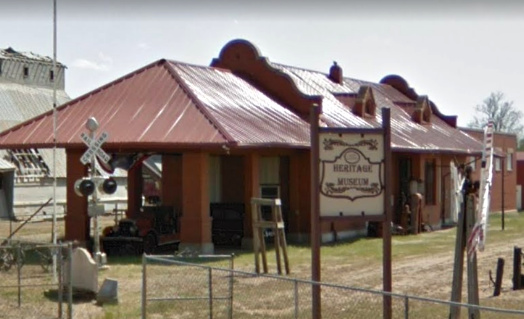
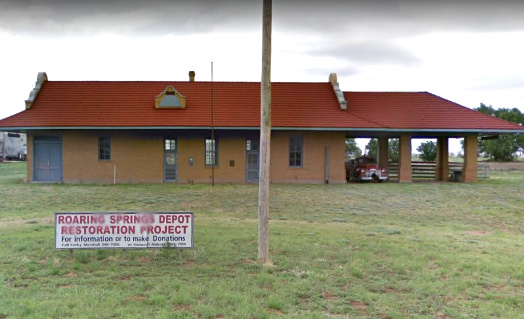
Toward the end of 1913, the QA&P's lease of the Acme Tap
was about to expire. The plant that owned the Acme Tap was no longer the Salina
company; ownership had passed to the American Cement Plaster Co. As the QA&P
sought to renew the Acme Tap lease, they also proposed to change the waybill
location for shipments originating on the Acme Tap as a means of differentiating
the two plants. The QA&P proposed "Clay-Bank" as the official location of
American's shipments, which American rejected. American was less well known;
having products identified as originating at Acme, a recognized source of such
goods, was considered beneficial to their brand. Either Acme Plaster or the QA&P complained
to RCT about continuing to identify Acme as the home of the American plant when
it was located more than a mile away. With RCT involvement, the
parties ultimately agreed that shipments from the American plant would be shown originating at "Agatite",
a trade name used by American. A larger stumbling block to a lease agreement was
American's concern that their customer details might be unlawfully exposed to
Acme Plaster. American's shipments were being handled by the QA&P, headed by
Samuel Lazarus, who had previously been the owner of (and still held a large
financial interest in) Acme Plaster. The opportunity for subterfuge was too
great to ignore. American refused to allow the Acme Tap lease to be renewed by
the QA&P. Instead, they "permanently" leased it to the FW&DC.
While the QA&P continued
switching Acme Plaster, the
FW&DC began switching the American plant, with Acme Tap waybills
showing origination at Agatite. This arrangement remained stable for many years
until both plants came under the control of Certain-teed Products Company in the
late 1920s (at least in part due to the death of Samuel Lazarus in March, 1926.) Certain-teed began working to restructure the operations of the two
plants into a cooperative activity which would require moving rail cars between
them. Unfortunately, this would create an interchange charge "per car"
for movements between the plants since the QA&P and Acme Tap were separate railroads.
Certain-teed wanted the QA&P to switch both plants, but the FW&DC, controlling a
permanent lease on the Acme Tap, vehemently opposed the idea, suggesting that
they should switch both plants. When the railroads and Certain-teed could not
agree to a solution, the FW&DC raised the stakes by giving six months' notice
that they were terminating the QA&P's trackage rights into Quanah. The QA&P responded by requesting ICC
permission to build its own line between Acme and Quanah, which was granted in
January, 1930.
Rather than use the land they had acquired in 1909 on the
south side of the FW&DC, the QA&P acquired new right-of-way on the north
side of
the FW&DC. On it, they built a new line out of Acme toward Quanah. Just
under a mile and half
west of Tower 27, the tracks angled to the northeast for a mile and then turned
due east for a half mile. There they intersected the Frisco tracks about three
quarters of a mile north of Tower 27, at the north end of the Frisco/QA&P yard. This new track went into service in March, 1931, providing faster transit
through Quanah for trains operating between Floydada and Oklahoma
City because it bypassed Tower 27. The QA&P also extended its depot tracks in
downtown Quanah east to Tower 27 and connected them to the Frisco's tracks so
they could reach their depots without using the FW&DC's depot spur (since they
no longer had rights on it.)
As the Depression began to set in, Certain-teed closed the Agatite plant, eliminating the need for the Acme Tap. The QA&P continued
switching the plant at Acme and signed an annual agreement renewed each year to
lease the few remaining FW&DC-owned tracks at Acme. The agreement also gave
the QA&P the right to operate the Acme Tap
tracks if the Agatite plant ever reopened. It never did, and the
Acme Tap was dismantled in 1938.
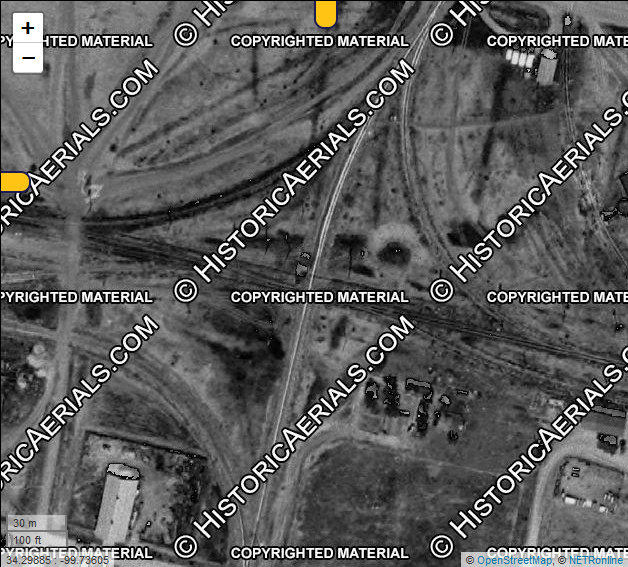

Above: These historic aerial images of the rail junction
near downtown Quanah show the changes between 1953 (left) and 1956 (right.) In
1953, the Frisco tracks still crossed the FW&D and went south down McClelland
St., off the bottom of the image. Tower 27 appears to be standing, but
the poor image quality prevents an accurate assessment. A 1953 FW&D Employee
Timetable lists some crossings as "Auto. Interlocked" whereas the
Quanah crossing is listed as merely "Interlocked", suggesting that the non-automated
(i.e. human operated) Tower 27 plant was still in use. By 1956, the Frisco
crossing of the FW&D had been removed and there's no apparent tower. There are
other track changes, one of which is a new track that crosses the FW&D left of
center, to the immediate left of a white equipment cabinet casting a shadow to
the north, presumably housing a new interlocker. A 1960 FW&D Employee Timetable
confirms the Quanah crossing has become "Auto. Interlocked" indicating the
interlocker design changed between 1953 and 1960. ((c)historicaerials.com)
Below:
This annotated satellite image shows the track
arrangement at Quanah in recent times. A) Tower 27 was located in this vicinity
where the Frisco tracks coming south from the Red River crossed the east/west
FW&D tracks. There is no longer any satellite evidence that tracks previously
continued south of the tower. B) North of Tower 27, the QA&P/Frisco yard is now
used by BNSF. The line continues to the north into Oklahoma. C) The QA&P bypass
that opened in 1931 remains intact for BNSF. D) This connection between the FW&D
track (south) and the QA&P track (north) shows that the former QA&P line into
Quanah is now used as a lengthy passing track for the main line. There are no
other crossovers and the two lines do not reconnect until they reach Acme, six
miles to the west. Also of interest on this map, the location of the QA&P depot
which hosts the Hardeman County Historical Museum is marked by the light blue
teardrop.
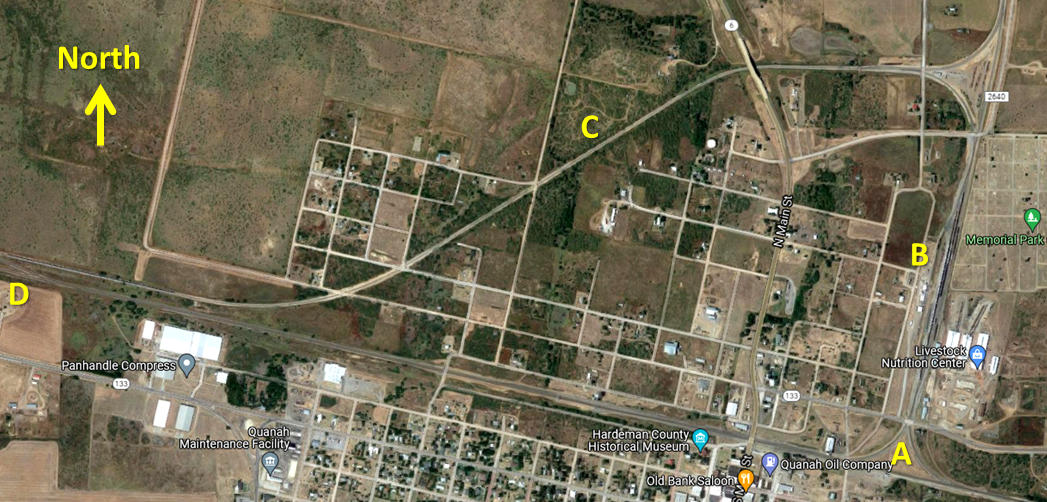
The new QA&P tracks from Acme to Quanah were on the north side of the FW&DC while the tracks from Acme to Floydada were south of it. The QA&P had no choice but to cross over the FW&DC at Acme. This required an interlocker which was commissioned by RCT as Tower 171. Tower 171 is the first interlocker not to appear in a table of active interlockers published by RCT. The last entry in the table of interlockers (dated December 31, 1930) in RCT's 1931 Annual Report was Tower 170. Beginning with the 1932 Annual Report, the table was omitted. RCT records, however, do show that the construction between Acme and Quanah occurred in 1931, so it is likely that Tower 171 was commissioned that same year. Most likely, this was an automatic interlocker from the outset. A June, 1940 FW&DC timetable shows it as such, and in May, 1930, RCT had begun to authorize automatic interlockers, the first ones being at Plainview and Lubbock.
 |
Left:
This map of Quanah, its railroads, and the terrain north and west of it
depicts the Acme Cement Plaster Co. and the Salina Cement Plaster Co. as
orange boxes labeled 'A' and 'S', respectively. The Acme Tap officially
ended at the Salina plant but there were additional tracks north of the
plant to reach gypsum mines along Groesbeck Creek. The QA&P spur to the
southwest of Tower 171 accessed a deposit of gypsite (gypsum mixed with
clay.) Below: When the private tracks were dismantled, some culverts were left behind.  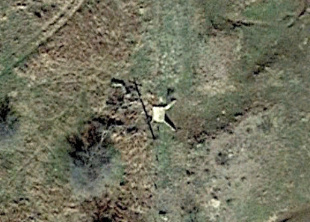 Google Earth, 2019 |
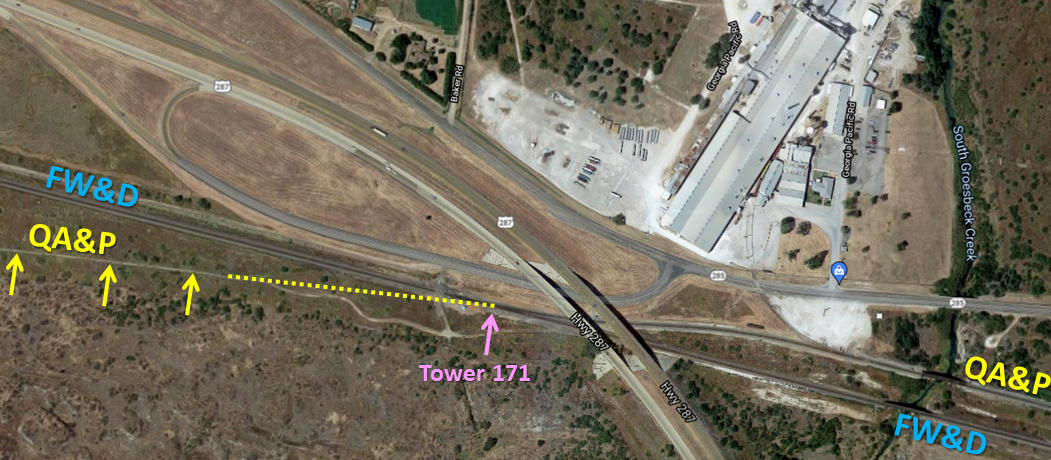
Above: This recent satellite view of Acme shows the former Acme
Cement Plaster Co. is now a Georgia Pacific facility along South Groesbeck
Creek. The former QA&P right-of-way to Paducah (yellow arrows and dashes) is
visible going west from the Tower 171 crossing.
Below: The former QA&P bridge over South Groesbeck
Creek still exhibits the name and logo. (Google Street View, March 2013)
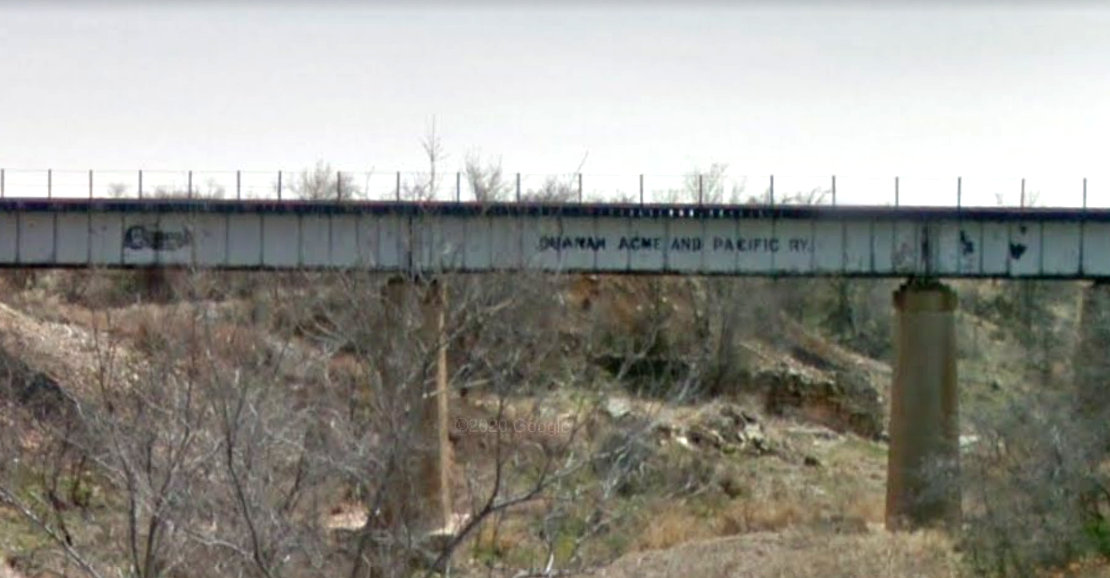
The QA&P served agricultural areas that generated
seasonal business, so it wanted the Santa Fe connection at Floydada as a means
of facilitating regular overhead traffic to help cash flow during the lean
months. QA&P management knew that local traffic was insufficient, that they
needed to be a link in moving freight between the Frisco and Santa Fe. Santa Fe
resisted the Floydada connection from the beginning, refusing to accede to any
connection at all. They compromised after an ICC hearing on the matter and both
railroads funded their own tracks to create the connection at Floydada which
opened on June 30, 1928. To Santa Fe, the exchange was only for local traffic,
hence they bitterly resisted
attempts to negotiate long haul tariffs via Floydada, preferring Avard, Oklahoma
as the only gateway for Frisco traffic. The QA&P fought back and refused to stop
soliciting such traffic. Though the numbers were not large, they continued to
mix non-local traffic into their interchanges with Santa Fe at Floydada. They
also agreed to use the same division of revenue that the Frisco would have
received for traffic through Avard. In their view, Santa Fe should welcome this
business since Santa Fe's haul west from Floydada was 194 miles shorter than
Santa Fe's haul west from Avard. Santa Fe's counterargument was that moving
freight between Floydada and their main line at Canyon required carrying it over
two branch lines that were not equipped to handle traffic of this nature.
Despite their objections, Santa Fe accepted the meager amount of non-local QA&P
traffic at Floydada and hoped it would go away. When it did not, they announced
in March, 1933, that they intended to close the Floydada gateway. They would
implement interchange restrictions by refusing to handle traffic that did not
originate or terminate on the QA&P, or on the Frisco south of Sapulpa and Enid,
Oklahoma. Everything else had to exchange at
Avard.
The QA&P filed a complaint with the ICC, but they lost the ICC's
regional examiner's adjudication in May, 1933. Undeterred, they re-filed their
case in more detail and with backing from the American Short Line Railroad
Association which viewed Santa Fe's actions as blatantly discriminatory against
a much smaller railroad. They lost again in late 1934 when ICC Division Four
examiners ruled 2 - 1 in favor of Santa Fe. Still undeterred, the QA&P filed for
reconsideration by the ICC's commissioners in Washington, DC, recasting their
argument as rate discrimination since the Floydada gateway wasn't completely
closed. In October, 1935, they lost once again when the full commission ruled in
favor of Santa Fe. Still undeterred (yes,
seriously...), the QA&P filed for rehearing and reconsideration by the
ICC's commissioners, again emphasizing the discrimination they were experiencing compared to Santa Fe's rates and divisions with
other railroads. For reasons known only to the ICC, they agreed to reopen and
rehear the case. In doing so, they requested substantial information from Santa
Fe regarding its connections and arrangements with other railroads at other
gateways. Santa Fe panicked; they did not want that kind of competitive data
released in a public setting such as an ICC examiner's hearing. But they had no choice, and
much of the information that came out during the hearing held in Oklahoma City
in October, 1936, bolstered the QA&Ps arguments. The ICC examiner found in favor
of the QA&P, and the ICC commissioners did also in February, 1938. By 1939, the Floydada gateway
was wide open to transcontinental traffic.
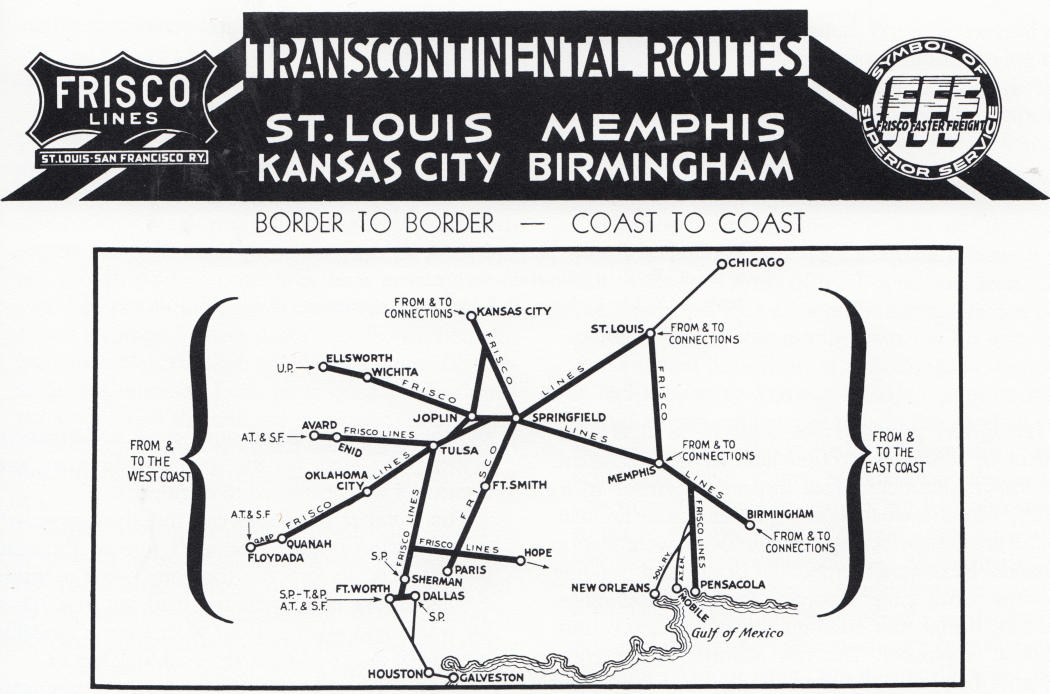
Above: The QA&P convinced
Frisco management to promote it as a critical link for transcontinental
routings. This ad showed how the Frisco was positioned to carry the middle segment of
transcontinental traffic, including separately depicting the QA&P and its
connection to the Santa Fe. Although Avard and Floydada both led to southern
California, Floydada certainly "looked" more appropriate for shipments headed
there!
(from
The Quanah Route, by Don L. Hofsommer, 1991, Texas A&M University Press.)
Floydada prospered reasonably well at the crossroads of a transcontinental rail link for the next three decades. Traffic maintained a steady flow, local citizens enjoyed better passenger rail options than most, and the local agricultural production moved efficiently to markets. Historic aerial imagery from 1957 shows a large triangular track arrangement in place on open land on the southeast side of town adjacent to the QA&P depot, near where the QA&P tracks arrived from the east. It appears that the QA&P had begun planning for some kind of large facility, or perhaps the tracks were laid to lure industrial customers to build there. Whatever the case, a new automobile distribution center was built beside the south track in 1959 with yard tracks installed for unloading vehicles. This enterprise brought new jobs and commerce to Floydada and substantial revenue to the QA&P and Frisco. The automobile distribution center expanded twice in the 1960s as additional carmakers sought to make use of it. By 1969, the facility was handling 3,000 cars per month, which likely had begun to include some of the initial wave of Japanese cars imported through the west coast and brought to Floydada by Santa Fe. Santa Fe eventually built their own vehicle distribution center in Amarillo.
|
|
When Chrysler teamed with the
Frisco to move automobiles by rail from St. Louis to the Dallas market, the success motivated
construction of a vehicle distribution facility at Floydada in 1959. Cars from Chrysler's factory near St. Louis arrived on the QA&P
and were then moved by truck to dealers across west Texas. The view at
left faces west
with the QA&P main line (and a Santa Fe exchange track beside it) entering
Floydada from the east near the bottom right corner. A switch on the QA&P sent auto racks to the
left down the south track of the wye to be moved into the facility for unloading.
The west track of the wye allowed reversing trains with empty car carriers
for the return trip to St. Louis. The east track of the wye led to the
QA&P depot and additional exchange tracks with Santa Fe.
(image from
The Quanah Route, by Don L. Hofsommer, 1991, Texas A&M University Press.) Above: Looking northwest, the rails are all gone at the east point of the Floydada wye, but the curvature remains implanted in the vegetation. The QA&P depot is long gone but might have previously been visible at the far right edge of this image. (Jim King photo, 1999) |
In 1959, Santa Fe, the QA&P and the Frisco initiated
twice daily transcontinental "hot shot" trains in each direction, with
locomotives and cabooses (and nothing else) being switched out at Floydada. This
required a few track changes to reduce transit delays since the original
connection there did not anticipate handling "through
trains." Among the changes, automatic interlockers were installed at
Lockney (Tower 212) and the east side of Plainview
(Tower 213.) The hot shot route also passed through
Tower 142 at Plainview.
Floydada's population
peaked in 1970 at around 4,000 and the local economy was good. It would not stay
that way. Santa Fe officials approached senior
management of the Frisco in the early 1970s to discuss closing the Floydada
gateway and moving all exchange traffic to Avard. Santa Fe did not want the
expense of upgrading the rail into Floydada which had become a maintenance issue. Floydada was a terminus for both railroads, so
the expense of maintaining the rails out of Floydada for
time-sensitive transcontinental freight was beyond what the local traffic alone in either
direction could justify. But at Avard, this was only true for the
Frisco. Avard was on Santa Fe's main line from Kansas City to Amarillo with rails maintained to a high standard.
For the Frisco, Avard was not much different than Floydada, a dead-end 175 miles west of Tulsa with little local traffic.
But critically, the route from Tulsa to Avard was easier, faster and much less
subject to delay compared to the QA&P. In the end,
the Frisco could not justify the cost of two transcontinental gateways with
Santa Fe. When they balked at giving up the automobile business at Floydada, Santa Fe
sweetened the offer by giving the Frisco a very favorable division of revenue
for any auto racks they routed to Santa Fe's vehicle distribution
center in Amarillo. Santa Fe also offered a better revenue split for all
exchanges through Avard as an additional incentive. A deal was struck in early
1973, and in August, the hot shots began running via Avard. Operations continued
on the QA&P, but during the off season, only a thrice-weekly local ran between
Quanah and Floydada.
Yet... the loss of daily
transcontinental traffic through Floydada was almost immediately replaced by a
deal between the FW&D, the QA&P and Santa Fe to run a daily FW&D train between
Acme and Lockney. A major derail on the FW&D tracks between Estelline and Sterley
had wiped out one of the two tunnels on that branch, necessitating extensive and lengthy repairs.
The temporary arrangement detoured FW&D trains between Acme and Lockney via Floydada to bypass the collapsed tunnel. At Lockney, FW&D trains returned to
their own rails south to Lubbock. The FW&D began talks with the Frisco
about acquiring the QA&P between Acme and Floydada rather than rebuild the
tunnel. The talks progressed to the point that a
deal was within reach. The FW&D needed Santa Fe to grant trackage rights on the
twelve miles of track between Floydada and Lockney that the FW&D had been using
for detours. This track was now lightly used since Santa Fe and the Frisco had
moved all of their interchange traffic to Avard. Everyone agreed to the deal,
including local Santa Fe management. Santa Fe senior management, however, chose
to kill the deal, not admitting, but apparently still harboring, animosity a
half-century later for the FW&D's invasion of the South Plains! The FW&D was
forced to repair their tunnel by "daylighting" what was left of it to be
able to resume operations on the branch at Estelline. The last detour train
was in January, 1975.
Long before the end of the 1970s, cattle shipping on the QA&P
had effectively disappeared, replaced by trucks on paved highways that had gradually
reached into the Caprock. This had contributed to reduced cash flow on the QA&P such
that the expense of maintaining operations to Floydada was becoming problematic. Burlington Northern (BN) had long owned the FW&D, and they
acquired the Frisco in 1980. New management was ready to cut costs, so
the QA&P tracks into Floydada were scheduled for abandonment. The last train
from Floydada to Quanah operated on May 5, 1981, and the 67 miles of track from
Paducah to Floydada was removed soon thereafter. Floydada fared little better in
the opposite direction. Santa Fe sold its Floydada branch line in 1990 and it was
abandoned in 1993. Floydada, the town that had four transcontinental freight trains
daily for more than a decade now had no trains at all.
In 1987, BN
abandoned the QA&P tracks between Acme and Paducah. The QA&P main line between
Acme and Quanah was retained to provide a long siding for BN beside the former
FW&D
main line. The QA&P had met its final demise. In 1996, BN merged with Santa Fe to form Burlington Northern Santa Fe
(BNSF.) The original FW&DC route from Ft. Worth to Amarillo remains in operation
by BNSF as do the former Frisco tracks north out of Quanah. BNSF
continued switching the Georgia-Pacific plaster and cement products plant at Acme
until it closed on March 1, 2023. Closing the plant could not have been easy for
Georgia Pacific's owner, Koch Industries, led by CEO Charles Koch. His dad Fred
was born in Quanah and founded Koch Industries. Fred's dad Harry was the owner
of the Quanah Tribune Chief newspaper.
Editor's Note: More than twenty years ago, I first researched the QA&P after reading Professor Don Hofsommer's book, The Quanah Route. I used it as an opportunity to get my dad out of his house for a road trip, something he always enjoyed. We drove the route, took some photos, ate a few greasy meals at diners, and generally enjoyed the trip and the scenery for a couple of days. When I returned, I compiled my information into an article for Clearance Card, the quarterly journal of the Southwest Railroad Historical Society. (I knew it would be accepted for publication because I was the Editor.) Because of the enormous debt I owed Professor Hofsommer's book, I researched his whereabouts and was able to determine that he was teaching at St. Cloud State University in Minnesota. Having no information beyond that, I mailed a thank you note and a copy of that Winter, 1999 issue of Clearance Card to Professor Hofsommer, care of the University's published address. I could only hope it would reach him. Three weeks later, you can imagine the shock I had when I opened my mailbox and pulled out a letter with my address typewritten on a Quanah, Acme & Pacific corporate envelope, more than a decade after the QA&P had ceased to exist. The letter inside, typed on QA&P letterhead, was a short thank you note from Professor Hofsommer. I finally had the privilege of meeting him and dining with him when he was the keynote speaker at the banquet of the NRHS national convention in Duluth, Minnesota in 2009. He explained that he had been given some corporate stationery during his research, and he still recalled sending me that letter ten years earlier. Special thanks go to Professor Hofsommer for his wonderful and detailed book about the QA&P.